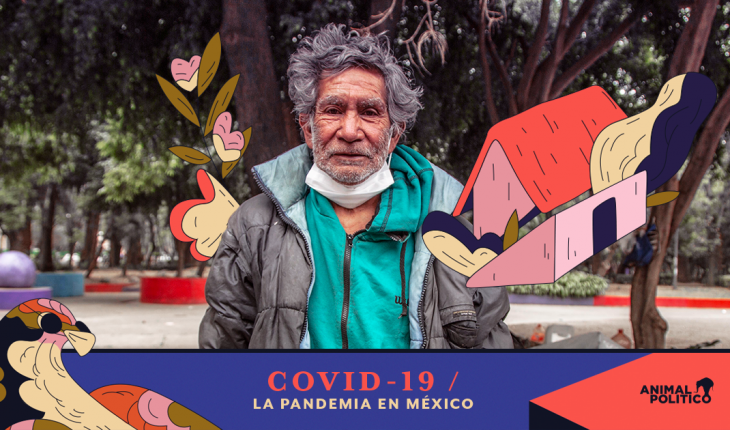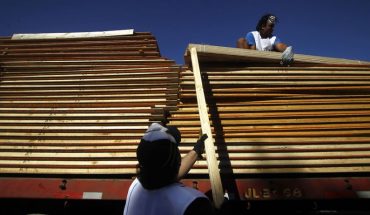The population living on the streets of Mexico was left out of any COVID-19 pandemic protection program. They did not have access to health services and no financial, employment or housing support.
According to an analysis by the National Social Development Policy Assessment Council (CONEVAL), the country’s 32 state governments launched 667 social programmes and actions to care for different population groups under the pandemic, however, none of them were aimed at people on the street.
Nor were they able to access any of the 78 programs that, according to CONEVAL, were implemented by state governments to serve people in poverty during the pandemic, because they require identity documents and most of them do not.
Social organizations point out that this population has increased in the last 12 months in an environment of abandonment by society and the authorities of the various government orders.
If this population already had little or almost nothing, with the advent of the pandemic the abandonment grew in different ways: the closure of public places and the “stay at home” left them without spaces to sell their products or to ask for money.
Public water intakes where they could be washed were out of reach and the few times they saw the authorities was because they came to take away their belongings or to threaten to take their children to shelters.
As far as possible, care has been taken not to get sick. Between fear of COVID and misinformation about it, they continue their lives on the streets, working where and how they can to earn enough to survive another day.
You may be interested in: ‘I’ve never lived on the street’: losing the house and employment because of COVID-19
“They’re barely surviving.”
In Mexico City, the country’s largest metropolis since the start of the pandemic, specific measures were taken for street populations, such as the establishment of a main and two emerging shelters, as well as brigades that walked the streets to offer support, says in interview with Animal Politics, the holder of the Secretariat of Inclusion and Social Welfare of the capital , Almudena Ocejo.
With the help of a truck donated to the Government of Mexico City by Turkey, they walk through some streets to offer medical reviews and give away antibacterial gel and water covers. To date, Welfare states that they have not found a single case of COVID among street populations.
“We always approach anyone in a street situation and offer the services at the hostel. The intention is that they can be in a protected space and safeguard their health and life, but 75% of them do not accept,” says Ocejo.
On vaccines, Dr. Ocejo says there will be a special process for people on the street, inside shelters and social assistance centers.
In the case of Jalisco, Juan Carlos Martín Mancilla, holder of the state DIF, explains that pantries were offered and people in a street situation were invited to a hostel, and that the local government allocated 5 million pesos so that this population can be cared for throughout this year.
Local authorities are unaware of the number of people living on the streets of Jalisco, however, they estimate that “there was an increase in people on the street because of the crisis. Our team goes out every day and we find people who lost their jobs and income and on the street found a way to live.”
According to Martín Mancilla, Jalisco is designing a new model of reintegration of people in street situations, “so that those who have already left the vices and are working can have a house. We’re going to give them a small basic housing kit to rejoin their families.” But so far it’s just a project.
To date, they claim that they have not detected people on the street with COVID in Jalisco and that health services are guaranteed for them, including the vaccine.
The official versions are challenged by civil society organizations, who claim that the supports have been insufficient and that not all the people who need them have been able to access them.
The Collective For Children’s Rights (CODENI), which works with people on the street in the capital of Jalisco, notes that people who were already in a state of vulnerability are the ones most at risk of coVID and who have passed the pandemic for various situations.
“In the absence of support, they have to look for other options to get the resources to survive, despite the closure of activities,” explains Amanda Cabrera, communication coordinator at CODENI.
The association has provided pantry support and information on how to prevent COVID contagions, but despite this, many families “are surviving hard, they are painful and hopeless cases because they are looking for ways to get money but precariousness increases rapidly and their conditions become more difficult.” And in other states the situation is similar.
No access to pandemic health services
According to the only official census on street populations in the country, prepared by the then Secretariat for Social Development, in 2017 there were 6 thousand 754 people in street situations in Mexico City, 4 thousand 354 living in public spaces and 2 thousand 400 in public and private hostels.
However, Luis Enrique Hernández, director of El Caracol, estimates that over the last year the number of members of the street populations has increased, mainly of children and young people, without being certain how many are.
“The population is in a more complex situation during the pandemic, mainly because of the subject of work. They can’t work on the subway and closed some spaces on the street, which leaves them with few resources for their rents or buy food,” he explains.
One year after the start of the pandemic, the balance of the association is not positive: “We continue to see a population that does not believe in the virus, without necessary preventive inputs and with the same historical conditions of not having access to health services”.
Vanesa, 37, corroborates this version. He lives with a dozen people on the outskirts of Hidalgo metro station, in the center of the capital, and comments that he has not received visits from the authorities or supports to cope with the pandemic, beyond what he gets from his own streetmates.
“There was a boy who got bad. An ambulance came and didn’t even check it out, he just told us he supposedly already had the virus… but since we’re in a street situation, they didn’t want to take him. We by our own means take him to the doctor in a pharmacy office, we all cooperate and support him with his medicines,” he says.
Fortunately his partner had nothing but a cold and eventually recovered. To take care not to get sick, Vanesa says they have blankets and clothes that neighbors and associations give them, “to cover us from the cold, so we protect each other.” They don’t have any more.
They don’t look like they’re going to have access to vaccines either. José Gerardo, a 64-year-old man who lives in an impromptu house with fabrics, plastics and chairs in a park located in the Cuauhtémoc mayoralty, in Mexico City, remains skeptical and eager to receive it… but he still doesn’t know if it’s going to be his turn.
As soon as she sees a group of women and men dressed in a red jumps jumps off, she greets them with a smile. They are the educators of the association El Caracol, who throughout the pandemic have dedicated the the most dedicated to visiting people who live on the streets to give them water covers, antibacterial gel and information on how to prevent COVID.
While being given soap and water to wash her hands, one of the educators asks if she has heard anything about the vaccine. He nods, says he knows he’s already arrived in Mexico and has to sign up for it to be applied, but he doesn’t have internet, phone, or computer. You also don’t know your CURP, so you can’t register.
He has identity documents, but he says they were stolen in an operative where the police took his belongings. Eli, the caracol educator, takes your details and tells her that they will visit you again in a few days to provide her with her registration, in case they manage to put you on the waiting list to receive a vaccine.
While this happens, the man says he takes the steps he can to avoid getting infected: “We clean ourselves a little bit when they give us water, that’s enough for a half bath.”
About whether he has received any visitors from the authorities of Mexico City to offer him support, José Gerardo points out that so far they have only gone to give him blankets and ask him to leave where he lives.
Read more: No money or internet at home, mothers went out to look for WiFi on the street for their children’s homework
Collateral damage
The lack of programmes specifically aimed at supporting street populations goes beyond the precariousness of their economic situation, limited access to health services and the risk to which they are exposed to the lack of basic hygiene inputs.
Social organizations such as El Caracol, Melel, CODENI and escuelita Móvil de Querétaro agree that disinformation persists between street populations about the virus and access to vaccines, which isin a lack of care that puts them most at risk.
In the case of Chiapas, Jenifer Haza of the Melel association warns that the fact that official figures showed a low trend of COVID contagions in the state has caused many of the people living and working on the street to be lax with measures such as the use of mouth covers, healthy distance and hand washing, and sometimes do not have spaces or inputs to do so.
For Melel, the authorities have not had specific plans to support this population, although the DIF in Chiapas notes that people with pantries have been supported.
In a survey conducted by Melel of 196 children and young people working selling various products on the streets of San Cristobal de las Casas, 90% said they are concerned about running out of food or income, so they decide to privilege the search for money over educational and care issues.
Maria, an informal merchant who lives up to date with a handmade clothing and toys stall in San Cristobal de las Casas, points out that throughout the year she goes from the pandemic she has not received offers of pantries or government support, only from associations like Melel.
“It’s been a year since the posts were closed. To date it’s affecting us a lot because there are no tourists, there’s no one to buy even if we have our job, and that leaves us without the money we make from the sale,” he says in interview.
As a result, your child has also had to work, neglecting his studies that were in themselves affected by remote mode, as they do not have a computer or internet. Maria hopes that as soon as the economic situation improves, he can go back to school. Although he knows his economic situation could get worse.
This is another situation of concern to associations that support street populations is the increase in the number of minors on the streets, the result of the abandonment of studies due to the closure of schools and the economic precariousness of families.
Jessica Martínez, in charge of the Querétaro Mobile School, an organization that has been touring the city center for 9 years to bring educational dynamics to minors, says that this increase in the number of children and young people on the street has been given without the government doing anything to care for them, although this situation has been presented since before the pandemic.
Querétaro, like other states, has a shelter that can be attended by the street population, however, as Jessica Martínez says, in most cases people do not want to be in it because they do not allow them to go out to work or receive them if they are intoxicated by some drugs.
“For them there is nothing, unfortunately, and not just now. We’ve been working on the street for years, we’ve been having trouble being treated, some have died of negligence, and all they do is retire them,” he says.
Although in this state, as the young people recount, they not only take away their things, but burn them so that they cannot continue to stay in some places.
“It is as if they think they are immortal, that nothing happens to them, that it does not hurt them or that because of their living conditions they do not need attention. They live the same social isolation as ever, because people don’t come near them, and even, in a very sad way, now what they’re saying surprised is that they haven’t died of COVID, as if they were waiting for that to happen.”
What we do at Animal Politics requires professional journalists, teamwork, dialogue with readers and something very important: independence. You can help us keep going. Be part of the team.
Subscribe to Animal Politics, receive benefits and support free journalism.#YoSoyAnimal





